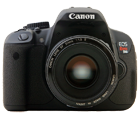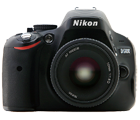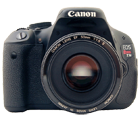Digital SLR Image Stabilization
If you've been comparing cameras I can guarantee that you've heard about digital SLR image stabilization.
It's a feature that many salespeople will declare is a "must-have" even though photographers have been getting by quite capably for years without it.
This is why it's important to fully understand what image stabilization can and cannot do. If you're going to pay extra for it, you had better know exactly what you're getting.
In the paragraphs that follow, I'll explain how this feature is implemented by the different camera manufacturers, and how you can leverage it to your best advantage.
Built-in or In The Lens
There are two different flavors of stabilization:
- It can be built into the camera body
- It can be built into the camera lens
The first is true for cameras made by Sony, Pentax, Samsung and Olympus. The second is true for cameras made by Canon and Nikon.
Image stabilization has been around for years in Canon and Nikon lenses. Canon calls this technology Image Stabilization (IS) while Nikon uses the term Vibration Reduction (VR).
If you want stabilization for a Canon or Nikon digital SLR, you'll have to buy a special lens that is labeled IS or VR. You will pay a premium for this, since lenses with stabilization cost more than non-stabilized alternatives.
By contrast, many new cameras from Sony, Olympus and Pentax include stabilization in the camera body.
Sounds like a huge advantage, doesn't it? I mean, why go out and buy expensive image stabilized lenses when you can just buy it built in to the camera instead?
There is one key difference to be aware of: when stabilization is in the lens, you can see it working. The image in the viewfinder doesn't jump around as much with a stabilized lens, making it easier to compose your photos.
When stabilization is built into the camera body, it doesn't have any impact on what you see in the viewfinder, but you still get the other benefit of this feature (which I'll talk about right now).
The Problem: Motion Blur
Digital SLR image stabilization sounds like an appealing feature, but what is it really good for?
Here's the quick overview:
- It helps you take clearer photos of non-moving subjects in dim light when you're not using the flash
- It helps you take clearer photos when the camera is moving around a lot (for example: from the window of a car on a rocky road)
- It helps you take clearer photos when using lenses with long focal lengths
- It does NOT help when you're trying to capture photos of fast-moving subjects
This last point is fundamental, and a common misunderstanding about just how much image stabilization can do.
Let's talk for a moment about what causes a blurry photograph. In order to capture a decent exposure, your digital SLR camera needs to let in the right amount of light.
There are two variables that control the volume of light that strikes the camera's sensor: the width of the lens opening (aperture) and the amount of time the sensor is exposed to light (shutter speed).
For every photo you take, the following two statements apply:
- As the light gets dimmer, the shutter must stay open longer to capture photos that are correctly exposed
- As the shutter stays open longer, you're more likely to wind up with a blurry photo
What's really causing the blur in your photos is MOTION. If you're working with a non-moving subject AND the camera is perfectly stable (attached to a tripod) then the shutter can be left open for several seconds and you'll still get a clear photo ![]() .
.
However, if either your subject or the camera is moving when you take a photo with a slow shutter speed, motion blur results ![]() .
.
When you're dealing with a fast-moving subject, the ONLY thing that is going to make your photo turn out clear is a fast shutter speed. Since stabilization has no impact on shutter speed, it won't help in this situation.
But stabilization can make a huge difference when you're trying to take photos in low light without a flash or a tripod.
Stabilization in the Real World
Imagine the following scenario: you're on vacation and come across an ancient cathedral. You've been sightseeing all day, so you're not lugging around a tripod with you. You step inside and want to capture some of the majesty of this old structure as the light filters in through the stained glass windows.
Using the tiny flash on top of your digital SLR will only light up a small area in front of you, not the cathedral ceiling.
Your only option is to use the little natural light that's available, and see if you can pull off the shot. Your camera keeps telling you that in order to get a photo that's correctly exposed, it's going to have to use a slow shutter speed of 1/8th of a second.
Without stabilization, this is a guaranteed blurry photo - slow shutter speeds enhance camera shake and create motion blur. Unless you can find a way to brace the camera or rest it on a solid surface you won't be able to capture a memory of this location.
With stabilization, you can hold the camera in your hands, use a slow shutter speed to accurately capture the natural light, and still get a photo that isn't a blurry mess.
Here's a different example: you'd like to take a photo of your kid playing around in the shady backyard.
He's running all over the place, and your camera is telling you that the best shutter speed it can manage is 1/250th of a second. No problem right? You've got a stabilized lens or camera.
Well, here's what will happen: the non-moving background will turn out crystal clear. But your kid - the focal point of your photo - WILL NOT be clear, because 1/250th of a second isn't fast enough to capture a child in motion.
Alternative Names
Anti-shake is described in many different ways by the camera manufacturers. This makes sense - they don't want to seem like they're all using the same technology.
While this benefits the camera companies, it can make things confusing for consumers trying to compare camera features.
With that in mind, here's how each camera company names their anti-shake:
| Manufacturer | Anti-Shake Terminology | Location |
| Canon | Image Stabilization (IS) | Lens |
| Nikon | Vibration Reduction (VR) | Lens |
| Olympus | Sensor-Shift Stabilization | Camera |
| Pentax | Shake Reduction | Camera |
| Samsung | Shake Reduction | Camera |
| Sony | Super Steady-Shot | Camera |
Buying Tip
Get image stabilization with your digital SLR if you:
- Take a lot of telephoto shots of non-moving subjects
- Take a lot of photos indoors and don't want to use a tripod
- Have naturally shaky hands and want all your photos to be clear
Don't make stabilization the focus of your camera purchase if you:
- Take photos of fast-moving subjects
- Always take photos in plenty of light
- Own a tripod and are happy to carry it with you
Related Links
| Digital SLR Home |

|




